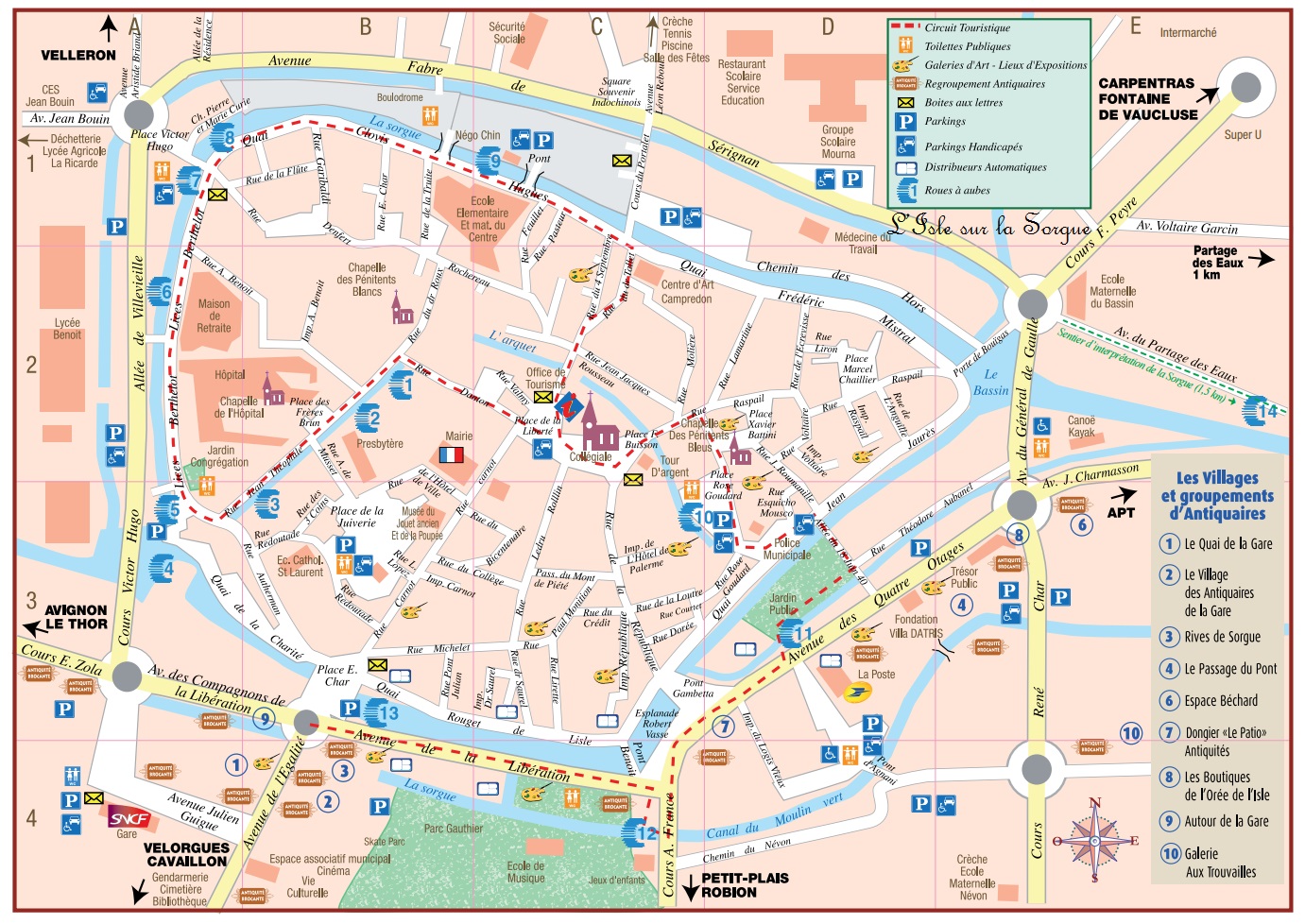L’Isle-sur-la-Sorgue
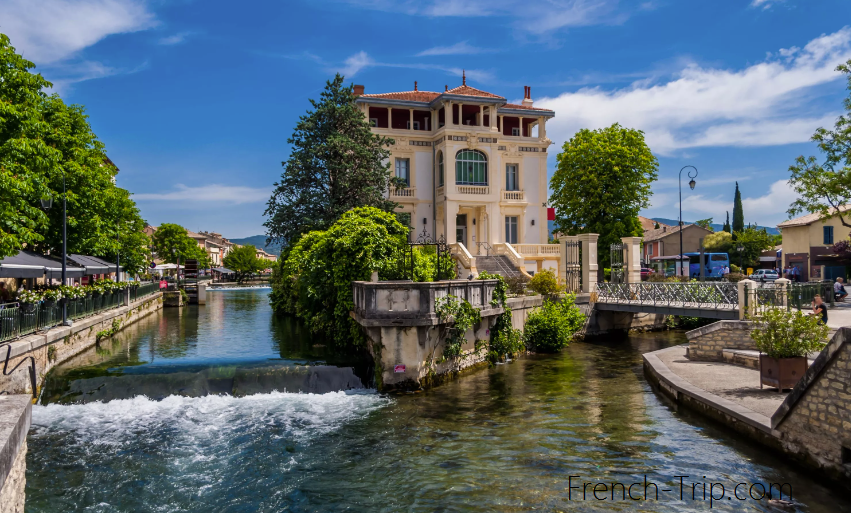
L’Isle-sur-la-Sorgue is a charming town located in the heart of Provence, just 20 kilometers east of Avignon. Situated along the Sorgue River, which not only lends its name to the town but has also played a vital role in its history, L’Isle-sur-la-Sorgue boasts a population of around 20,000 residents. Often referred to as the “Venice of Provence,” the town’s strategic location by the river provided protection, a source of sustenance, and drove the local industry for centuries.
Since the 1960s, L’Isle-sur-la-Sorgue has become renowned for its specialization in the antique trade. It has emerged as the third most significant antique trading center globally, following London and Paris. The town hosts two major international antique fairs, one during Easter and another on August 15th, making it a hotspot for antique enthusiasts and collectors from around the world.
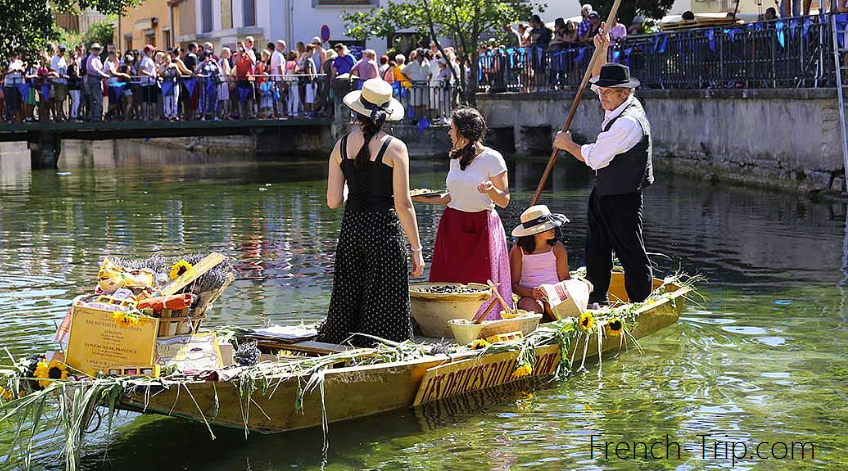
Travel guide:
L’Isle-sur-la-Sorgue, a picturesque town in the heart of Provence, is a hidden gem waiting to be explored. With its charming canals, vibrant markets, and rich history, it offers a unique and authentic experience for travelers. Here’s why L’Isle-sur-la-Sorgue is worth a visit, when to go, its main attractions, and what to explore in the surrounding area.
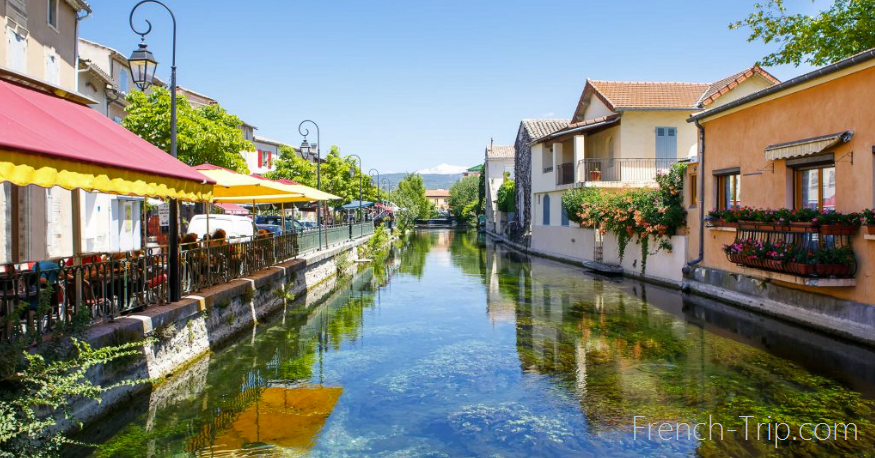
Why Visit L’Isle-sur-la-Sorgue:
- Antique Capital: L’Isle-sur-la-Sorgue is renowned as one of the world’s top destinations for antique lovers. Its numerous antique shops, markets, and fairs make it a paradise for collectors and enthusiasts.
- Scenic Canals: The town’s enchanting canals crisscrossing the old town give it the nickname “Venice of Provence.” Stroll along the waterways, cross charming bridges, and enjoy the peaceful ambiance.
- Lively Markets: L’Isle-sur-la-Sorgue hosts vibrant markets throughout the week, including the famous Sunday market. Here, you can shop for fresh produce, local crafts, antiques, and more.
- Historical Sites: Explore historical landmarks like the Church of Notre-Dame-des-Anges, the Old Silk Factory, and the Papal Palace, which offer glimpses into the town’s rich past.
- Outdoor Activities: The surrounding countryside offers opportunities for outdoor adventures, such as kayaking on the Sorgue River, hiking, and picnicking in the scenic Luberon Regional Natural Park.
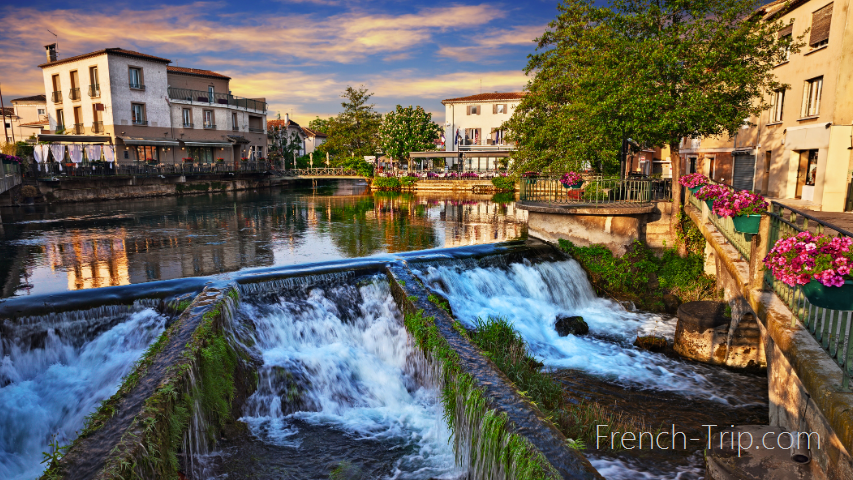
When to Visit:
The best time to visit L’Isle-sur-la-Sorgue is during the spring (April to June) and early autumn (September to October) when the weather is mild, and crowds are smaller. The town comes alive during its annual antique fairs on Easter and August 15th, attracting collectors from around the world.
History of L’Isle-sur-la-Sorgue:
Once known as “Insula,” the charming town of L’Isle-sur-la-Sorgue adopted its current name on August 18, 1890. The name derives from “L’Isle,” meaning “island,” and “Sorgue,” the river that plays a significant role in the town’s identity. In the 12th century, this river served as a defensive moat surrounding the city’s walls, which were eventually demolished in 1795. The Sorgue River also powered numerous mills, contributing to the town’s industrial prowess. It facilitated the production of items such as oil, flour, silk, paper, linen, carpets, and fabric dyeing. This bustling trade led to the establishment of two annual fairs and two weekly markets in the town. The present-day Sunday market traces its origins back to November 9, 1596.

In the 1960s, L’Isle-sur-la-Sorgue underwent a transformation and became a hub for antique enthusiasts. Often referred to as the “Venice of Provence,” it has since become Europe’s premier antique center, second only to London and Paris. The town hosts major antique events on Easter, Pentecost, August 15th, and All Saints’ Day, attracting visitors from around the world. During these events, the town welcomes both antique aficionados (approximately 120,000 visitors) and over 200 of the finest professional dealers.
The 100th International Fair of Art and Antiques took place in L’Isle-sur-la-Sorgue during the Easter weekend of 2016 (March 26-27, 2016), marking a significant milestone in the town’s rich history of antiques and art.
Get in:
- By Car: Renting a car is a convenient option, with well-connected roads to the town.
- By Train: The town has its own train station, “L’Isle-sur-la-Sorgue – Fontaine-de-Vaucluse,” connecting to regional trains.
- TER Provence map
- TER PDF map
- Train Avignon Centre to L’Isle-sur-la-Sorgue: direct, 25 – 28 min, 5.70 €
- Train Vitrolles – Aéroport Marseille Provence to L’Isle-sur-la-Sorgue: direct, 1:10, 15.70 €
- Train Cavaillon to L’Isle-sur-la-Sorgue: direct, 6 min, 3.10 €
- By Bus: ZOU! network connects various towns and cities in the Provence-Alpes-Côte d’Azur region, including L’Isle-sur-la-Sorgue, Avignon, and other nearby destinations.
- Bus lines, stopping in L’Isle-sur-la-Sorgue: 906, 913, 914, 920, 921, 57
- Bus 906 – to Avignon
- Bus 913 – to Cavaillon & Carpentras
- Bus 914 – to Bonnieux – Apt (timetable)
- Bus 920 – to Avignon & Carpentras
- Bus 921 – to Fontaine-de-Vacluse – Coustellet
- Tickets – 2,10€
- By Plane: You can fly into Avignon-Provence Airport (15km away) or Aéroport Marseille Provence (further but with more flight options).

Attractions of L’Isle-sur-la-Sorgue:
Short attraction list:
- Château de Mousquety and Moulin de Mousquety.
- Collégiale Notre-Dame-des-Anges.
- Chapelle Saint-Andéol de Velorgues, built in the 11th-12th centuries in the Romanesque style.
- Chapelle de Pénitents Blancs, dating back to the 16th century.
- Chapelle de la Congrégation des Hommes, from the 17th century.
- Chapelle de l’hôpital, built in the 18th century.
- Chapelle de l’ancienne maison de la Charité (Chapel of the Former House of Charity, Hôtel Jean Favier), from the 19th century.
- Chapelle Saint-Gervais, in the classical style.
- Chapelle des Pénitents Bleus, dating back to the 16th century, now used as a theater.
- Remains of the first Ursuline convent in France, from the 16th century.
- Couvent des Capucins, from the 17th century, with a chapel.
- Ruins of the rural chapel of Saint-Pancrace (Chapelle Saint-Pancrace).
Museums:
- Musée de l’école d’autrefois (Museum of the Old School).
- Campredon-Centre d’Art (Campredon Art Center).
Attractions on map:
Sorgue River
The Sorgue River has played a significant role in the history of L’Isle-sur-la-Sorgue. Dating back to August 8, 1467, it was prohibited by law to wash or pollute the river Sorg under the threat of fines. The river Sorg has been a lifeline for the town, fueling its prosperity through activities such as fishing, workshops, and industrial factories that harnessed the river’s power.
Fishermen’s Legacy
L’Isle-sur-la-Sorgue began as a small fishing village, and the street names in the town still reflect its fishing heritage with names like Rue de la Loutre (Otter Street), Rue de l’Anguille (Eel Street), Rue de la Truite (Trout Street), and Rue de l’Écrevisse (Crayfish Street).
In the 19th century, fishing thrived in L’Isle-sur-la-Sorgue, with around 15,000 river crayfish caught daily. The locals held exclusive fishing rights in the Sorgue River, the source of the Rhone River. For centuries, the local catch graced the tables of important churchmen, legates, and vice-legates of Avignon.
The fishermen used special boats known as “nego-chin” for their fishing expeditions.
Source of the Sourge river
Don’t miss the natural wonder of L’Isle-sur-la-Sorgue—the Sorgue River. Originating in Fontaine de Vaucluse, the river splits into two branches here. The water in the river is always refreshingly cool, with temperatures hovering around 13°C (55°F) both in summer and winter.
Water Mills
In L’Isle-sur-la-Sorgue, there used to be 66 water mills, with 49 of them located in the town center, including 17 on the Arquet Canal. Today, only 15 mills remain in the town and its surroundings. The natural energy of the Sorgue River allowed for industrial development. The last family workshop, Brun De Vian-Tiran, established in 1808, maintains the complete production cycle in L’Isle-sur-la-Sorgue: spinning, weaving (for carpets), and making blankets, quilts, shawls, and scarves from noble fibers sourced from around the world.
Collégiale Notre-Dame-des-Anges
The Collégiale Notre-Dame-des-Anges (Collegiate Church of Our Lady of the Angels) is an architectural gem of L’Isle-sur-la-Sorgue. Initially, it was a basilica of the Collegiate of St. Lawrence in 1222, but later, at the initiative of the Bishop of Cavaillon, it was renamed Notre-Dame-des-Anges (Our Lady of the Angels). In the 17th century, the church underwent expansion and was lavishly adorned in the Italian style. The project was led by the Avignon architect François de Royers de la Valfrenière. With its chapels and galleries, the church stands as a splendid example of Baroque architecture. It was consecrated in 1672 by the Bishop of Cavaillon, Jean-Baptiste de Sade (from the family of the infamous Marquis de Sade, who was imprisoned in the nearby Lacoste castle for his scandalous writings).
On the church’s façade, above the Tourist Office door, you can spot the engraved date “MDCCLXXIX,” corresponding to the year 1779. The inscription “Liberté-Égalité-Fraternité” (Liberty, Equality, Fraternity) on the church’s façade is a testament to the struggle between clerics and radicals during the separation of church and state. The church’s façade showcases a style typical of the Jesuit order, and you can also find sundials above the entrance.
Le Cadran Lunaire
Explore the historical significance of lunar calendars, which played a vital role in determining planting and harvest times, as well as predicting weather patterns. The combination of solar and lunar clocks showcases the importance of this knowledge for the town’s residents in the past.
L’Orgue Historique de Mentasti
Visit the historic organ of the church, dating back to the seventeenth century. This organ is classified as a historical monument and reflects the town’s rich musical heritage.
Les Juifs de L’Isle
Along the road to Caumont, you can find the Jewish cemetery, which was used to bury Jewish residents until the early 20th century. This cemetery serves as a testament to the existence of the Jewish community in the town. The old Jewish quarter, present in L’Isle-sur-la-Sorgue since the 13th century, was enclosed and could only be accessed through two doors. In 1498, Jews were expelled from the French kingdom and sought refuge in Comtat Venaissin, a historical region in southern France around Avignon, which belonged to the popes and was governed by a regent from Carpentras (it became part of France only after the Revolution and a plebiscite). In 1624, Jews were forced to gather in Avignon, Carpentras, Cavaillon, and L’Isle-sur-la-Sorgue, where their activities contributed to the prosperity of the towns. In 1791, recognized as full citizens, Jews gradually left their ghetto.
La Tour D’Argent
This medieval tower, built in the late nineteenth century by members of the baronial consulate, has been classified as a historical monument since 2012.
Les Armoiries
The town’s coat of arms features fire on a golden background with a blue river at the bottom. Two herons surround it, along with the motto “Ardet in hostem,” meaning “It burns against the enemy.”
Les Antiquaires: L’Isle-sur-la-Sorgue is a paradise for porcelain enthusiasts and antique lovers. It is the largest antique market center in Provence and a significant antique market hub in all of Europe. The number of antique shops has continuously grown since the first one opened in L’Isle in 1978. There are now approximately 300 shops offering furniture, art, textiles, jewelry, books, wrought iron items, and more. International antique exhibitions are held in L’Isle-sur-la-Sorgue during Easter and on August 15th.
Walking tour:
Explore the enchanting town of L’Isle-sur-la-Sorgue through a walking tour that will lead you through its charming streets and reveal its hidden gems. This map provides you with an itinerary to discover the town’s rich history, cultural heritage, and natural beauty on foot. Immerse yourself in the allure of L’Isle-sur-la-Sorgue as you follow this curated walking tour, which promises an unforgettable journey through this Provencal treasure.
Markets in L’Isle-sur-la-Sorgue
In L’Isle-sur-la-Sorgue, you can immerse yourself in the vibrant market scene, offering a delightful array of options to explore and discover the local culture. Here’s a handy guide to the town’s markets:
- Tuesday: Experience the quintessential Provençal market from 6 AM to 2 PM in the town center.
- Sunday: Don’t miss one of France’s largest markets, open from 6 AM to 2 PM, also located in the town center.
- Farmers’ Market: Enjoy fresh produce and local goodies near Petit Palais every Sunday from March to November, running from 6 AM to 2 PM.
- Floating Market: A unique annual event that takes place on the first Sunday of August.
- Flea Market: Explore the treasures of the flea market every Sunday on avenue des 4 otages in the town center.
These markets offer a wonderful opportunity to savor the flavors and traditions of L’Isle-sur-la-Sorgue.
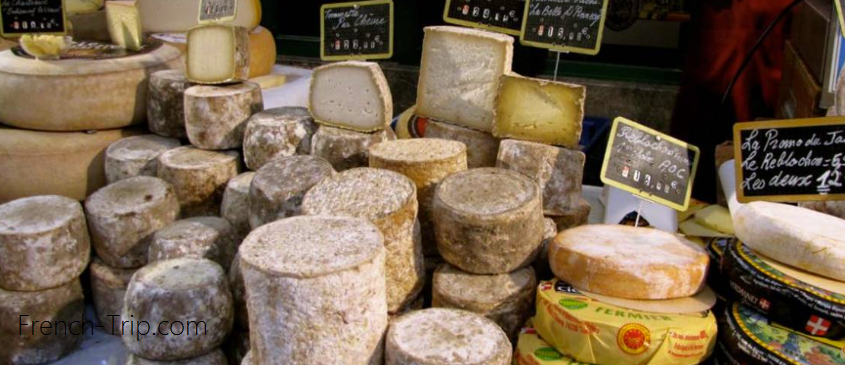
Festivals:
L’Isle-sur-la-Sorgue is a town that knows how to celebrate and embrace its vibrant culture. Here’s a list of some of the exciting festivals and events that take place in L’Isle-sur-la-Sorgue throughout the year:
- Festival de la Sorgue (July): Celebrate the beauty of the Sorgue River with this festival in July.
- Corso Nautique (Last weekend of July): Enjoy the Corso Nautique, a lively event that takes place on the last weekend of July.
- Floating Market (First Sunday of August): Don’t miss the unique Floating Market that happens on the first Sunday of August.
- Courses Hippiques (July and August): Experience the thrill of horse racing during the months of July and August.
- Foire Internationale Brocante & Antiquités, Foire Internationale d’Art Contemporain, Foire Internationale du Livre Ancien FILA (Easter and August 15th): Explore the world of antiques and art during these international fairs held on Easter and August 15th.
- Grand Live OPT Poker (March – April): If you’re a poker enthusiast, check out the Grand Live OPT Poker event held in March and April.
- Festival Trace de Poète (Spring): Immerse yourself in a world of poetry, philosophy, theater, music, and visual arts at the Festival Trace de Poète, held every spring.
- Festival Lilenzik (Late May): Experience contemporary music at its finest during the two-day Festival Lilenzik held in late May.
- Festivals in Provence: all most valuable festivals, celebration and carnivals in region Provence-Alpes-Côte d’Azur
These festivals and events offer a fantastic opportunity to engage with the vibrant cultural scene of L’Isle-sur-la-Sorgue.
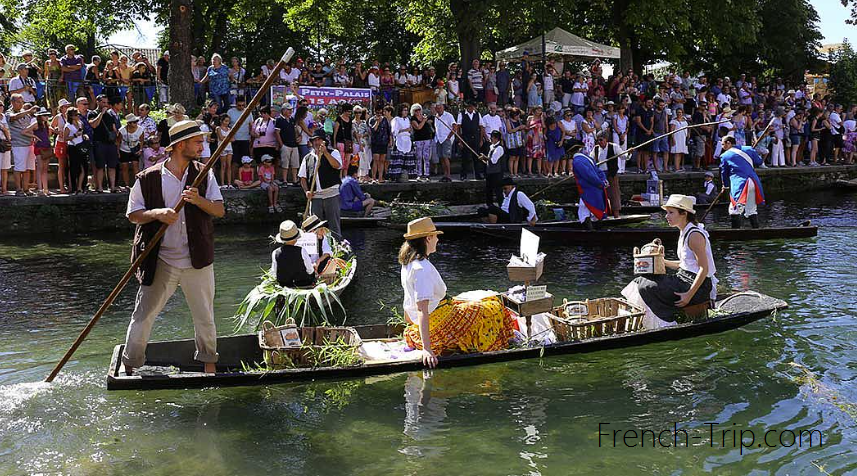
What to See Around L’Isle-sur-la-Sorgue:
- Fontaine-de-Vaucluse: Just a short drive away, explore the charming village of Fontaine-de-Vaucluse, known for its mysterious spring and picturesque setting.
- Gordes: Visit the nearby hilltop village of Gordes, listed as one of the “Most Beautiful Villages in France,” and admire its stunning architecture and panoramic views.
- Luberon Regional Natural Park: Explore the Luberon Park’s scenic landscapes, hiking trails, and other charming villages like Bonnieux, Roussillon, and Ménerbes.
- Avignon: Take a day trip to the historic city of Avignon to see the Palace of the Popes and the famous Pont Saint-Bénézet.
L’Isle-sur-la-Sorgue’s unique blend of history, natural beauty, and antique treasures makes it a must-visit destination in Provence. Whether you’re an antique aficionado or simply seeking a charming getaway, this town offers an unforgettable experience.
L’Isle-sur-la-Sorgue on map:
Archives
Calendar
| M | T | W | T | F | S | S |
|---|---|---|---|---|---|---|
| 1 | 2 | 3 | 4 | 5 | 6 | 7 |
| 8 | 9 | 10 | 11 | 12 | 13 | 14 |
| 15 | 16 | 17 | 18 | 19 | 20 | 21 |
| 22 | 23 | 24 | 25 | 26 | 27 | 28 |
| 29 | 30 | 31 | ||||
